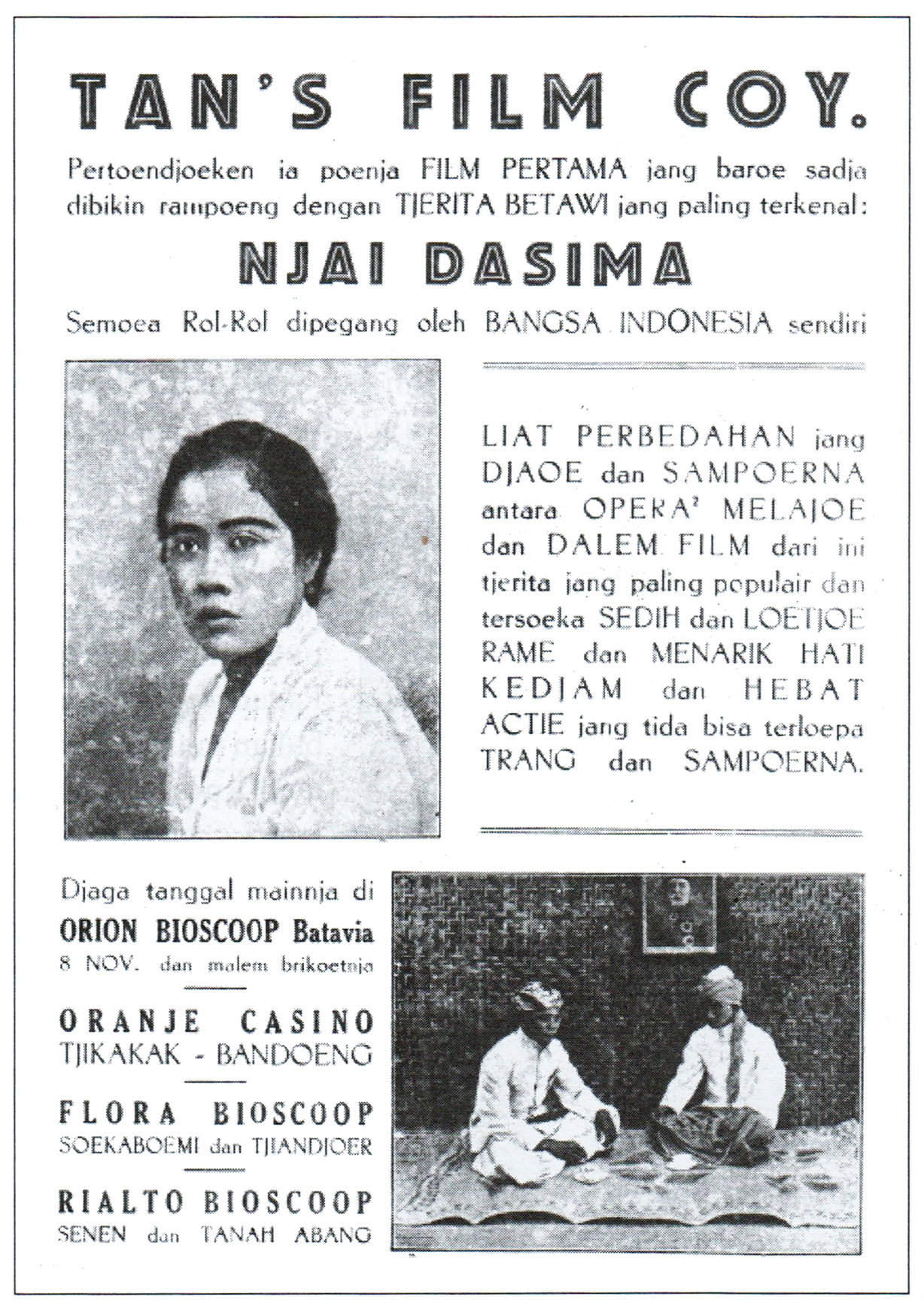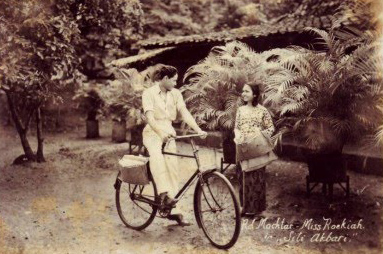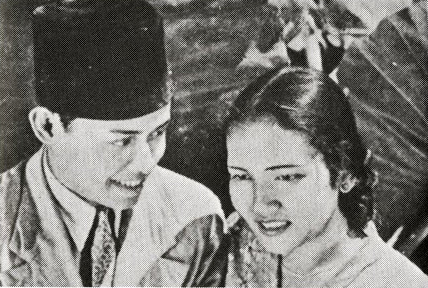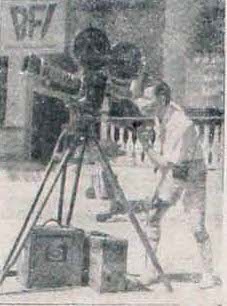|
Tan's Film
Tan's Film was a film production house in the Dutch East Indies (modern Indonesia). Established by the brothers Tan Khoen Yauw and Tan Khoen Hian on September 1, 1929, its films were mostly targeted at native ethnic groups. Starting with '' Njai Dasima'' in 1929, the company released fifteen movies before ultimately being dissolved after the Japanese occupation. The Tans and the Wong brothers established Tan & Wong Bros in 1948 to continue this work. History First iteration Tan's Film Company was established by Tan Khoen Yauw and his brother Tan Khoen Hian on September 1, 1929. It was one of three studios established in the Dutch East Indies that year, together with Nansing Film Corporation and another Chinese-owned studio. Tan's established a large studio building on Defensielijn v.d. Bosch (now Bungur Besar Raya Street). It had several divisions, including costuming, filming, and decor. The Tans, who had been raised in Kwitang, Batavia (modern day Jakarta) and grown up in ... [...More Info...] [...Related Items...] OR: [Wikipedia] [Google] [Baidu] |
Jakarta
Jakarta (; , bew, Jakarte), officially the Special Capital Region of Jakarta ( id, Daerah Khusus Ibukota Jakarta) is the capital and largest city of Indonesia. Lying on the northwest coast of Java, the world's most populous island, Jakarta is the largest city in Southeast Asia and serves as the diplomatic capital of ASEAN. The city is the economic, cultural, and political centre of Indonesia. It possesses a province-level status and has a population of 10,609,681 as of mid 2021.Badan Pusat Statistik, Jakarta, 2022. Although Jakarta extends over only , and thus has the smallest area of any Indonesian province, its metropolitan area covers , which includes the satellite cities Bogor, Depok, Tangerang, South Tangerang, and Bekasi, and has an estimated population of 35 million , making it the largest urban area in Indonesia and the second-largest in the world (after Tokyo). Jakarta ranks first among the Indonesian provinces in human development index. Jakarta's busin ... [...More Info...] [...Related Items...] OR: [Wikipedia] [Google] [Baidu] |
Bachtiar Effendi
Bachtiar Effendi (also spelled Bachtiar Effendy; after 1903 – 1 April 1976) was an Indonesian film actor and director who also served as a cultural critic. Beginning his film career in 1930, he made several works for Tan's Film before joining a drama troupe. After spending ten years in British Malaya, he returned to Indonesia and directed several more films before being sent to Italy as a press attaché. He lived in the country for most of the remainder of his life, having found disfavour after supporting the Revolutionary Government of the Republic of Indonesia. Early life Effendi was the younger brother of Rustam Effendi, a communist-sympathising poet born in 1903. Their family was originally from Padang, West Sumatra, although the brothers left Padang for their education. Effendi dropped out of senior high school – a level of schooling already more than most native children received – and instead of becoming a law student as his parents intended he beca ... [...More Info...] [...Related Items...] OR: [Wikipedia] [Google] [Baidu] |
Sorga Ka Toedjoe
''Sorga Ka Toedjoe'' (; vernacular Malay for ''Seventh Heaven''; also advertised under the Dutch title ''In Den Zevenden Hemel'') is a 1940 film from the Dutch East Indies (present-day Indonesia) directed by Joshua and Othniel Wong for Tan's Film. It follows an older couple (Kartolo and Annie Landouw) who are reunited by another, younger couple (Roekiah and Djoemala) after years of separation. The black-and-white film, the first production by Tan's Film after the departure of Rd Mochtar, featured ''kroncong'' music and was targeted at lower-class native audiences. It was a commercial and critical success. Roekiah and Djoemala took leading roles in three more films before Tan's closed in 1942. ''Sorga Ka Toedjoe'' is now thought lost. Plot Rasminah (Roekiah) is living with her blind aunt Hadidjah ( Annie Landouw) in Puncak, a village south-east of Buitenzorg (now Bogor). Hadidjah has been separated from her husband, Kasimin, for several years, ever since she accused him of ... [...More Info...] [...Related Items...] OR: [Wikipedia] [Google] [Baidu] |
Roekihati
''Roekihati'' is a 1940 film from the Dutch East Indies. Directed by the brothers Joshua and Othniel Wong and produced by Tan's Film, it follows a young village woman who goes to the city and encounters various difficulties. Targeted at lower-class audiences, it was shot in black-and-white and starred Roekiah and Raden Djoemala. Plot The village girl Roekihati (Roekiah) goes to the city to find money so she can care for her ailing mother and father. She first works at the home of a rich playboy before going to become a singer at a restaurant; both of these jobs fail miserably. Eventually she marries Mansoer ( Rd. Djoemala), a coupling to which Mansoer's father objects vehemently. With his family and friends urging him on, Mansoer begins to fall for a city girl named Aminah, ignoring Roekihati. However, when Mansoer sees that Roekihati is faithfully attending to him despite how he treats her he decides that he was wrong and returns to her. Production ''Roekihati'' was directed by ... [...More Info...] [...Related Items...] OR: [Wikipedia] [Google] [Baidu] |
Saeroen
Saeroen ( Perfected Spelling: Saerun; fl. 1920s–1962) was an Indonesian journalist and screenwriter. Born in Yogyakarta, he became a journalist after a time working at a railway station. By the mid-1930s he had established the daily ''Pemandangan'' with Oene Djunaedi and was writing editorials with the pen name Kampret. When the paper was dissolved, Saeroen drifted into the film industry as a writer, making his debut with Albert Balink's ''Terang Boelan'' (1937). Much of his later life was spent working with several minor publications. Early life and career Saeroen was born in Yogyakarta, Dutch East Indies, to a courtier (''abdi dalem'') and his wife. After failing to complete his schooling at two different elementary schools, during which time he worked cleaning horse-drawn carriages and delivering newspapers, he passed a written test equivalent to an elementary school diploma. He then went to Batavia (modern-day Jakarta) to work at a train station. After several months he was ... [...More Info...] [...Related Items...] OR: [Wikipedia] [Google] [Baidu] |
Oriental Film
Oriental Film was a film production company in Batavia, Dutch East Indies (now Jakarta, Indonesia). Established by ethnic Chinese businessman Tjo Seng Han in 1940, it completed four black-and-white films before it was closed in 1941. All the company's films were screened into the 1950s but may now be lost. They were directed by two men, Njoo Cheong Seng and Sutan Usman Karim, and launched the careers of actors such as Dhalia and Soerip. Established during the revival of the Indies film industry, Oriental released its first film, ''Kris Mataram'', in July 1940. It starred Njoo's wife Fifi Young, and relied on her fame as a stage actress to draw audiences. This was followed by a further three films, which were targeted at low-income audiences and extensively used ''kroncong'' music. Their final production was ''Panggilan Darah'' in 1941, which was completed after Njoo and Young had migrated to Majestic Film. Oriental was unable to recoup its expenses of renting a Dutch-owned stu ... [...More Info...] [...Related Items...] OR: [Wikipedia] [Google] [Baidu] |
Siti Akbari
''Siti Akbari'' is a 1940 film from the Dutch East Indies (now Indonesia) directed by Joshua and Othniel Wong and produced by Tan Khoen Yauw. Starring Roekiah and Rd Mochtar, it follows a couple while the husband commits adultery. Plot Siti Akbari (Roekiah) is living happily with her husband. When he begins to wander she stays faithful and he eventually comes back to her. Production ''Siti Akbari'' was directed by Joshua and Othniel Wong, ethnic Chinese brothers who had received film training in the United States and been active in the film industry of the Dutch East Indies since 1929's ''Lily van Java''. The film's producer, Tan Khoen Yauw, was co-owner of the production studio that made the work, Tan's Film. The black-and-white talkie featured vocals by the actresses Annie Landouw and Titing, with the ''keroncong'' group Lief Java providing background music. Several further cast members, including the stars Mochtar, Roekiah, and her husband Kartolo, had migrated to Tan's aft ... [...More Info...] [...Related Items...] OR: [Wikipedia] [Google] [Baidu] |
Zorro
Zorro (Spanish language, Spanish for 'fox') is a fictional character created in 1919 by American pulp magazine, pulp writer Johnston McCulley, appearing in works set in the Pueblo of Los Angeles in Alta California. He is typically portrayed as a dashing masked vigilante who defends the commoners and indigenous peoples of California against corrupt and tyrannical officials and other villains. His signature all-black costume includes a cape, a hat known as a , and a mask covering the upper half of his face. In the stories, Zorro has a high Bounty (reward), bounty on his head, but is too skilled and cunning for the bumbling authorities to catch, and he also delights in publicly humiliating them. Because of this, the townspeople started calling him ''"El Zorro"'' due to his foxlike cunning and charm. Zorro is an acrobat and an expert in various weapons, but the one he employs most frequently is his rapier, which he uses often to carve the initial "Z" on his defeated foes, and othe ... [...More Info...] [...Related Items...] OR: [Wikipedia] [Google] [Baidu] |
Gagak Item
''Gagak Item'' (; Vernacular Malay for ''Black Raven'', also known by the Dutch title ''De Zwarte Raaf'') is a 1939 bandit film from the Dutch East Indies (now Indonesia) directed by Joshua and Othniel Wong for Tan's Film. Starring Rd Mochtar, Roekiah, and Eddy T. Effendi, it follows a masked man known only as "Gagak Item" ("Black Raven"). The black-and-white film, which featured the cast and crew from the 1937 hit ''Terang Boelan'' (''Full Moon''), was a commercial success and received positive reviews upon release. It is likely lost. Production ''Gagak Item'' was directed by brothers Joshua and Othniel Wong; filming the work in black-and-white, they also handled sound editing. It was produced by Tan Khoen Yauw of Tan's Film and starred Rd Mochtar, Roekiah, Eddy T. Effendi, and Kartolo. The Wongs and cast had first worked together on Albert Balink's 1937 blockbuster ''Terang Boelan'' (''Full Moon''), before joining Tan's Film in 1938 for the highly successful '' Fatima' ... [...More Info...] [...Related Items...] OR: [Wikipedia] [Google] [Baidu] |
Netherlands Indies Gulden
The Netherlands Indies gulden was the unit of account of the Dutch East Indies from 1602 under the United East India Company ( nl, Vereenigde Oost-Indische Compagnie; VOC), following Dutch practice first adopted in the 15th century (gulden coins were not minted in the Netherlands between 1558 and 1681 and none circulated in the Indies until a century later). A variety of Dutch, Spanish and Asian coins were in official and common usage. After the collapse of the VOC at the end of the 18th century, control of the islands reverted to the Dutch government, which issued silver 'Netherlands Indies' gulden and fractional silver and copper coins until Indonesian independence in 1949. History Prior to European contact A number of forms of payment were found throughout the archipelago prior to European contact. Stamped gold and silver masa and kupang date from the 9th century, with later coins substantially debased, with 13th-century silver masa containing only copper, while gold coins w ... [...More Info...] [...Related Items...] OR: [Wikipedia] [Google] [Baidu] |
Roekiah
Roekiah ( Perfected Spelling: Rukiah; 31 December 1917 – 2 September 1945), often credited as Miss Roekiah, was an Indonesian ''kroncong'' singer and film actress. The daughter of two stage performers, she began her career at the age of seven; by 1932 she had become well known in Batavia, Dutch East Indies (now Jakarta, Indonesia), as a singer and stage actress. Around this time she met Kartolo, whom she married in 1934. The two acted in the 1937 hit film ''Terang Boelan'', in which Roekiah and Rd Mochtar played young lovers. After the film's commercial success, Roekiah, Kartolo, and most of the cast and crew of ''Terang Boelan'' were signed to Tan's Film, first appearing for the company in their 1938 production '' Fatima''. They acted together in two more films before Mochtar left the company in 1940; through these films, Roekiah and Mochtar became the colony's first on-screen couple. Mochtar's replacement, Rd Djoemala, acted with Roekiah in four films, although these ... [...More Info...] [...Related Items...] OR: [Wikipedia] [Google] [Baidu] |
Terang Boelan
''Terang Boelan'' (; Indonesian for "Full Moon", ''Terang Bulan'' in the Perfected Spelling System) is a 1937 film from the Dutch East Indies (now Indonesia). Written by Saeroen, directed by Albert Balink, and starring Rd Mochtar, Roekiah and Eddie T. Effendi, ''Terang Boelan'' follows two lovers who elope after one is almost forced to marry an opium smuggler. The film was shot in the Indies and Singapore, and was partially inspired by the 1936 Hollywood film ''The Jungle Princess''. It was aimed at native audiences and included ''keroncong'' music, which was popular at the time, and several actors from Balink's previous work ''Pareh'' (1936). ''Terang Boelan'' was a commercial success in both the Indies and abroad, earning 200,000 Straits dollars in British Malaya. This success revived the faltering domestic film industry and inspired films aimed at Malay audiences in Malaya, creating a formula of songs, beautiful scenery and romance that was followed for decades afterwards. Th ... [...More Info...] [...Related Items...] OR: [Wikipedia] [Google] [Baidu] |






%2C_cover.jpg)
